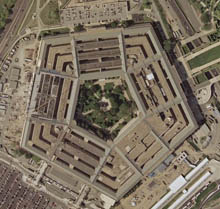 War Costs has pointed out before the moaning, groaning and outright deception coming from defense industry titans like Lockheed Martin -- and their defenders on Capitol Hill -- over planned defense cuts, supposedly a menace their companies cannot survive if you believe their rhetoric. They attempt to paint themselves as victims of sequestration put in motion by the Budget Control Act of 2011, voted for by the likes of Sen. John McCain, who hit the road last week with other senators to scare swing states about possible job losses as a consequence of the planned cuts he helped put into motion.
War Costs has pointed out before the moaning, groaning and outright deception coming from defense industry titans like Lockheed Martin -- and their defenders on Capitol Hill -- over planned defense cuts, supposedly a menace their companies cannot survive if you believe their rhetoric. They attempt to paint themselves as victims of sequestration put in motion by the Budget Control Act of 2011, voted for by the likes of Sen. John McCain, who hit the road last week with other senators to scare swing states about possible job losses as a consequence of the planned cuts he helped put into motion.
All in all, it's a coordinated offensive to obscure the true health of an industry addicted to the boom two wars have delivered to their bottom line. PricewaterhouseCoopers reported 2011 was a second straight year of record profits for the defense and aerospace industries.
Should sequestration occur, the Pentagon's base budget will be about the same as it was in 2006, adjusted for inflation, according to the Congressional Budget Office. So how was the defense industry doing in 2006, a time of two wars raging in Iraq and Afghanistan?
The Project on Government Oversight's Ben Freeman reports:
And, at the end of 2006, according to an analysis by the Project On Government Oversight, the nation’s five top defense contractors employed more people than they did at the end of 2011.
At the end of 2006, the five companies employed a total of 577,200 people, according to reports they filed with the Securities and Exchange Commission. That was slightly more than the 520,900 they reported at the end of 2011.
The POGO study included Lockheed Martin, Boeing, General Dynamics, Northrop Grumman, and Raytheon.
To be sure, there are wrinkles in the numbers. One big one: Northrop Grumman split from its Huntington Ingalls shipbuilding business in 2011, taking the Huntington Ingalls employees out of the year-end jobs total for the top five contractors. But, adding back those 38,000 employees, the five contractors still employed 3.3 percent more workers at the end of 2006 than at the end of 2011.
Over the five-year period, total employment at the companies declined even as the total federal contract dollars awarded to the firms rose.
Read Freeman's entire analysis for much more.
This is just more proof that industry and its always-able-and-willing partners in Congress -- they know who pays them -- will say anything to keep high levels of revenue and profit up despite the wishes of the American public, who are more and more apt to demand cuts to the Pentagon budget. The Stimson Center found in a recent survey that even people in heavy defense manufacturing districts advocate for cuts on par with the rest of the country.
The fearmongering about losing jobs isn't about the employees of these companies. It's about the easy money the industry seems to think is their right to receive. It's about CEO pay -- Lockheed Martin CEO Robert Stevens took home compensation in 2011 to the tune of $25 million. Boeing and Northrop Grumman CEOs aren't far off that number. It's about maintaining influnce -- lobbying expenditures by top industry players in the first quarter of 2012 came in at $15.9 million. It's about solidifying the status quo, not about a "doomsday" scenario for national security or the economy. POGO's valuable analysis is an another reminder of that.









Showing 1 reaction
Sign in with